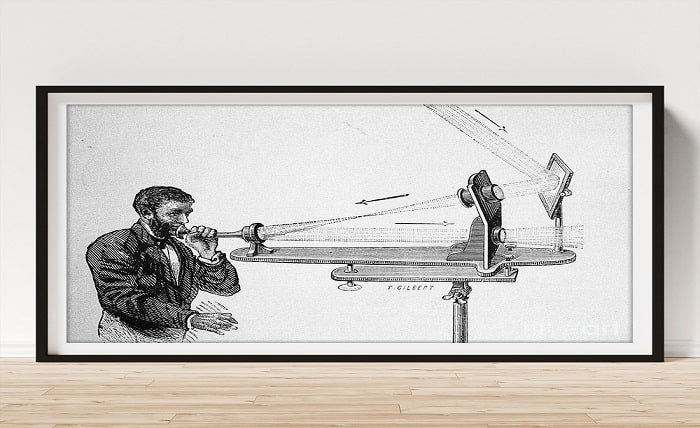The Photophone: Revolutionizing Communication and Beyond

In the ever-evolving world of communication technology, the photophone stands as one of the most intriguing inventions. Long before the rise of modern video conferencing tools or smartphones, the photophone laid the foundation for many of the communication systems we rely on today. By merging the power of light with sound, the photophone opened up a new era of long-distance communication that has influenced how we interact with the world.
In this blog post, we’ll dive deep into the history, technology, and impact of the photophone. From its invention by Alexander Graham Bell to its potential future applications, the photophone has proven to be an important milestone in the development of communication technologies.
What is a Photophone?
The photophone is a device that transmits sound using light waves, essentially making it a precursor to modern fiber-optic and wireless communication technologies. Invented by Alexander Graham Bell in 1880, the photophone was a groundbreaking innovation that enabled the transmission of voice through light rather than electrical signals, as used in the traditional telephone. This novel concept paved the way for numerous advancements in communication, eventually leading to the development of technologies like fiber optics and even parts of modern mobile communication systems.
The fundamental principle behind the photophone is the conversion of sound into light, which is then transmitted over a distance and converted back into sound. The device worked by using a beam of light to carry sound vibrations, which were captured by a receiver and then amplified for the listener.
The History of the Photophone
To truly understand the significance of the photophone, it’s important to look at its historical context. In the late 19th century, Alexander Graham Bell was already famous for his invention of the telephone. However, Bell was also deeply interested in sound and light, and he envisioned a way to send voice signals using light rather than electrical impulses.
In 1880, Bell and his assistant, Charles Sumner Tainter, successfully demonstrated the photophone for the first time. The device worked by using sunlight reflected from a mirror to carry sound waves. As sound waves altered the mirror’s angle, it modulated the reflected light, transmitting the sound. The photophone made use of a sensitive selenium cell, which could detect changes in the light intensity caused by the sound vibrations.
Despite its groundbreaking nature, the photophone did not immediately catch on. The technology was limited by the available materials, and it was dependent on sunlight, which made it impractical for many applications. However, it was still a monumental achievement in the history of communication.
How the Photophone Works
The technology behind the photophone is fascinating, as it blends principles of both sound and light. To better understand how this early device worked, let’s break it down:
- Sound Conversion to Light: The photophone first captured sound waves, typically from a person speaking, and converted them into a modulated beam of light. This was done using a mirror that vibrated in response to the sound. The vibrations of the sound waves caused slight movements in the mirror, changing the angle at which light was reflected.
- Transmission of Light: The modulated light was then sent through the air, typically over a short distance, to a receiver. Since the light was modulated, it carried the pattern of the sound waves along with it.
- Reception and Conversion: On the receiving end, the light was directed at a selenium cell, which was capable of detecting changes in the intensity of the light. These changes were then translated back into sound waves, which could be heard through a speaker or receiver.
The photophone worked similarly to a basic optical telegraph, but with the added innovation of using sound instead of visual signals. While the technology was rudimentary by today’s standards, it demonstrated the potential for using light as a medium for communication.
The Significance of the Photophone
The photophone was groundbreaking for several reasons. First, it demonstrated that sound could be transmitted using light rather than electrical signals, opening up possibilities for future communication systems. Second, it highlighted the potential for wireless communication—something that was far ahead of its time.
In many ways, the photophone laid the groundwork for modern communication technologies. While it was not widely adopted in its time, its principles were later adapted in the development of fiber-optic technology. Fiber-optic cables, which now serve as the backbone of global communication networks, rely on the transmission of light to carry large amounts of data over vast distances. The success of the photophone in demonstrating light-based communication is, in hindsight, a precursor to these modern systems.
Modern Uses and Innovations Inspired by the Photophone
Although the photophone itself is no longer in use, its impact on modern communication systems is undeniable. The most direct successor to the photophone is fiber-optic communication. Fiber optics use light to transmit data over long distances with high speed and minimal loss. This technology is now used in everything from internet connections to telecommunication networks and medical imaging systems.
Additionally, the photophone contributed to the broader field of optical communication, which has found applications in various industries. For example, laser-based communication systems, which are used in satellite communication and high-speed internet connections, owe their origins to the principles demonstrated by Bell and Tainter.
The photophone’s role in early wireless communication also influenced the development of technologies such as Wi-Fi and Bluetooth, which use radio waves to transmit data wirelessly. These advancements, built on the foundation of the photophone, are integral to the modern connected world.
Challenges and Limitations of the Photophone
Despite its brilliance, the photophone was not without its limitations. Some of the challenges faced by Bell and Tainter when developing the photophone included:
- Sunlight Dependency: One of the primary limitations of the photophone was that it relied on sunlight. As a result, the device could only function effectively in daylight, making it impractical for night-time communication or in locations with limited sunlight.
- Short Range: The photophone could only transmit over short distances due to the limitations of light-based communication. The strength of the light beam decreased rapidly with distance, making it ineffective for long-range communication.
- Technology and Materials: The materials and technology of the time were not advanced enough to fully realize the potential of the photophone. The selenium cells, for example, were not as sensitive as needed, which restricted the clarity and quality of the transmitted sound.
Despite these drawbacks, the photophone paved the way for future innovations, and its principles were later refined and expanded upon to create more practical and reliable communication systems.
The Future of Photophone-Inspired Technologies
Looking forward, the principles behind the photophone may continue to shape communication technologies in new and innovative ways. As the world becomes increasingly reliant on fast, efficient, and wireless communication, technologies inspired by the photophone’s light-based communication could play a central role.
For instance, researchers are exploring ways to use visible light communication (VLC) systems to transmit data at high speeds, a technology that is closely related to the principles behind the photophone. VLC uses light-emitting diodes (LEDs) to send data through visible light, offering a potential solution for high-speed internet and wireless data transfer. This is an area of ongoing research, with companies and institutions exploring its potential applications for everything from smart homes to autonomous vehicles.
Additionally, advances in quantum communication, which is based on the transmission of quantum states of light, may also be influenced by the legacy of the photophone. Quantum communication holds the promise of ultra-secure transmission of data, which could revolutionize industries such as cybersecurity and financial services.
Conclusion
The photophone was an early yet visionary invention that transformed the way we think about communication. While it may not have achieved widespread practical use in its time, its principles laid the foundation for many of the communication technologies that define our modern world. From fiber-optic networks to wireless data transmission, the impact of the photophone can still be seen today.
Looking to the future, the principles behind the photophone continue to inspire advancements in optical and quantum communication, promising even faster and more secure methods of transmitting data. As technology evolves, the legacy of the photophone will continue to shape the next generation of communication systems.
FAQs
1. What is a photophone, and who invented it?
A photophone is a device that transmits sound using light waves, invented by Alexander Graham Bell in 1880.
2. How does a photophone work?
The photophone works by converting sound into light waves, which are then transmitted and received using light-sensitive cells, before being converted back into sound.
3. Why wasn’t the photophone widely adopted?
The photophone faced challenges such as its reliance on sunlight, short transmission range, and the limitations of the technology and materials at the time.
4. What is the connection between the photophone and modern communication technologies?
The photophone laid the foundation for fiber-optic communication and other light-based communication technologies, which are essential for modern internet and telecommunication networks.
5. Can photophone-inspired technologies be used today?
Yes, photophone-inspired technologies, such as visible light communication (VLC), are being explored for high-speed data transfer and wireless communication in various industries.





